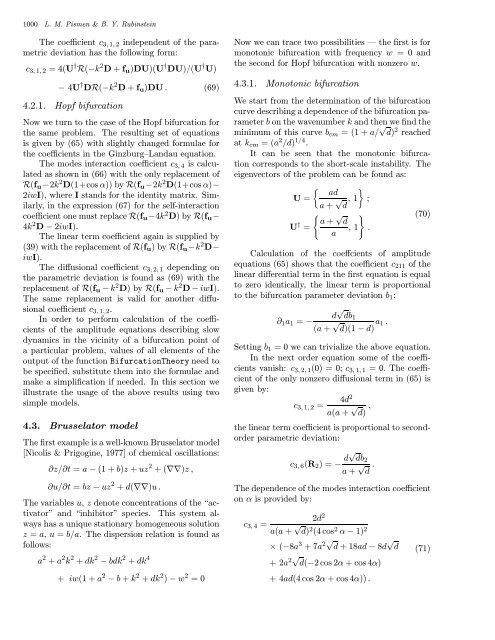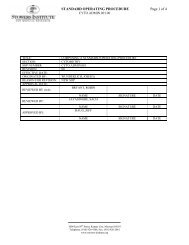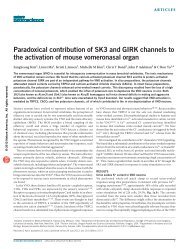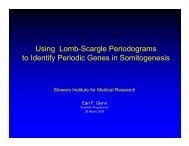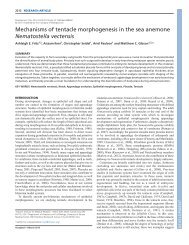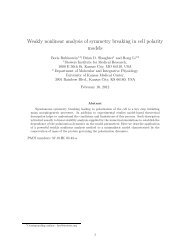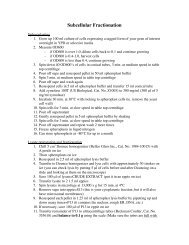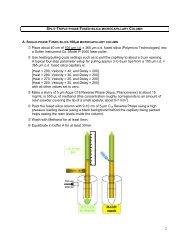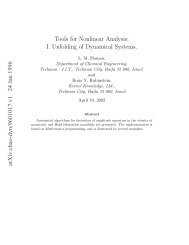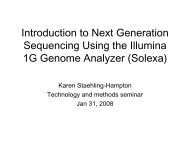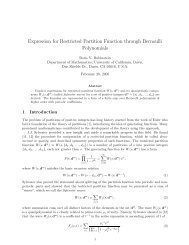Computer Tools for Bifurcation Analysis: General Approach with
Computer Tools for Bifurcation Analysis: General Approach with
Computer Tools for Bifurcation Analysis: General Approach with
Create successful ePaper yourself
Turn your PDF publications into a flip-book with our unique Google optimized e-Paper software.
1000 L. M. Pismen & B. Y. Rubinstein<br />
The coefficient c 3, 1, 2 independent of the parametric<br />
deviation has the following <strong>for</strong>m:<br />
c 3, 1, 2 =4(U † R(−k 2 D+f u )DU)(U † DU)/(U † U)<br />
− 4U † DR(−k 2 D + f u )DU . (69)<br />
4.2.1. Hopf bifurcation<br />
Now we turn to the case of the Hopf bifurcation <strong>for</strong><br />
the same problem. The resulting set of equations<br />
is given by (65) <strong>with</strong> slightly changed <strong>for</strong>mulae <strong>for</strong><br />
the coefficients in the Ginzburg–Landau equation.<br />
The modes interaction coefficient c 3, 4 is calculated<br />
as shown in (66) <strong>with</strong> the only replacement of<br />
R(f u −2k 2 D(1+cos α)) by R(f u −2k 2 D(1+cos α)−<br />
2iwI), where I stands <strong>for</strong> the identity matrix. Similarly,<br />
in the expression (67) <strong>for</strong> the self-interaction<br />
coefficient one must replace R(f u −4k 2 D)byR(f u −<br />
4k 2 D−2iwI).<br />
The linear term coefficient again is supplied by<br />
(39) <strong>with</strong> the replacement of R(f u )byR(f u −k 2 D−<br />
iwI).<br />
The diffusional coefficient c 3, 2, 1 depending on<br />
the parametric deviation is found as (69) <strong>with</strong> the<br />
replacement of R(f u − k 2 D)byR(f u −k 2 D−iwI).<br />
The same replacement is valid <strong>for</strong> another diffusional<br />
coefficient c 3, 1, 2 .<br />
In order to per<strong>for</strong>m calculation of the coefficients<br />
of the amplitude equations describing slow<br />
dynamics in the vicinity of a bifurcation point of<br />
a particular problem, values of all elements of the<br />
output of the function <strong>Bifurcation</strong>Theory need to<br />
be specified, substitute them into the <strong>for</strong>mulae and<br />
make a simplification if needed. In this section we<br />
illustrate the usage of the above results using two<br />
simple models.<br />
4.3. Brusselator model<br />
The first example is a well-known Brusselator model<br />
[Nicolis & Prigogine, 1977] of chemical oscillations:<br />
∂z/∂t = a − (1 + b)z + uz 2 +(∇∇)z,<br />
∂u/∂t = bz − uz 2 + d(∇∇)u.<br />
The variables u, z denote concentrations of the “activator”<br />
and “inhibitor” species. This system always<br />
has a unique stationary homogeneous solution<br />
z = a, u = b/a. The dispersion relation is found as<br />
follows:<br />
a 2 + a 2 k 2 + dk 2 − bdk 2 + dk 4<br />
+ iw(1 + a 2 − b + k 2 + dk 2 ) − w 2 =0<br />
Now we can trace two possibilities — the first is <strong>for</strong><br />
monotonic bifurcation <strong>with</strong> frequency w =0and<br />
the second <strong>for</strong> Hopf bifurcation <strong>with</strong> nonzero w.<br />
4.3.1. Monotonic bifurcation<br />
We start from the determination of the bifurcation<br />
curve describing a dependence of the bifurcation parameter<br />
b on the wavenumber k and then we find the<br />
minimum of this curve b cm =(1+a/ √ d) 2 reached<br />
at k cm =(a 2 /d) 1/4 .<br />
It can be seen that the monotonic bifurcation<br />
corresponds to the short-scale instability. The<br />
eigenvectors of the problem can be found as:<br />
{ } ad<br />
U =<br />
a + √ d , 1 ;<br />
{ √ }<br />
(70)<br />
a + d<br />
U † = , 1 .<br />
a<br />
Calculation of the coeffcients of amplitude<br />
equations (65) shows that the coefficient c 211 of the<br />
linear differential term in the first equation is equal<br />
to zero identically, the linear term is proportional<br />
to the bifurcation parameter deviation b 1 :<br />
d √ db 1<br />
∂ 1 a 1 = −<br />
(a + √ d)(1 − d) a 1 .<br />
Setting b 1 = 0 we can trivialize the above equation.<br />
In the next order equation some of the coefficients<br />
vanish: c 3, 2, 1 (0) = 0; c 3, 1, 1 =0.The coefficient<br />
of the only nonzero diffusional term in (65) is<br />
given by:<br />
4d 2<br />
c 3, 1, 2 =<br />
a(a + √ d) ,<br />
the linear term coefficient is proportional to secondorder<br />
parametric deviation:<br />
c 3, 6 (R 2 )=− d√ db 2<br />
a + √ d .<br />
The dependence of the modes interaction coefficient<br />
on α is provided by:<br />
2d 2<br />
c 3, 4 =<br />
a(a + √ d) 2 (4 cos 2 α − 1) 2<br />
× (−8a 3 +7a 2√ d+18ad − 8d √ d<br />
+2a 2√ d(−2cos2α+cos4α)<br />
+4ad(4 cos 2α +cos4α)) .<br />
(71)


